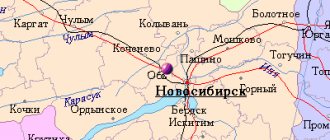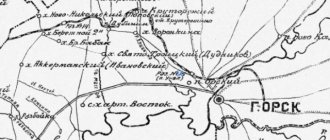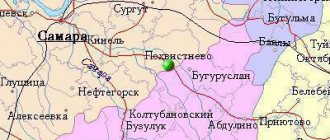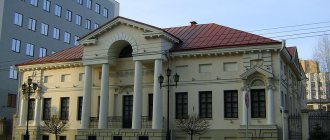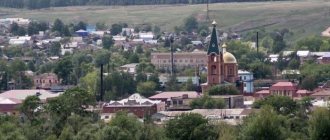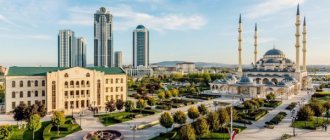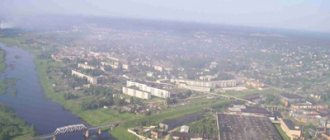Founded: 1595
Salekhard celebrates city day on
the 2nd Sunday of September
.
In 2022,
this date is
September 11
.
Sale-Harn - “village on the cape”
Salekhard
(from Nenets Sale-Kharn - “village on a cape”) is a Russian city, the administrative center of the Yamalo-Nenets Autonomous Okrug, located on the right bank of the Poluy not far from its confluence with the Ob.
More than 2,000 years ago, on the site of Salekhard lived a people who later became part of the titular peoples of the North - the Nenets and Khanty. This place was inhabited twice more: in the 6th and 12th centuries - this is evidenced by the archaeological site Zelenaya Gorka.
In 1595
The Obdorsky fort was founded, which marked the beginning of Salekhard. Initially, Obdorsk was a “rotation” fortress, as the documents of the Siberian Order say: “there is no reason to be at that outpost until June, because the place is empty.”
In 1635, the fort received the name Obdorsk outpost, and from this year “customs heads” began to be sent to Obdorsk. In 1641, to replace the two-tower fort, a new one with four towers was built, with two carriageways and two observation towers.
At the same time, two barns were built in the fort for trading people and a permanent customs house was established. In 1731, by decree of Anna Ioannovna, Obdorsk was further fortified. A permanent detachment of 50 Cossacks was created in the fortress to protect yasak collectors.
In 1799, the Tobolsk governor issued an order to abolish the Obdorsk “arsenal”. At the beginning of the 19th century, the village became famous for the famous Obdorsk New Year's fair. By January, merchants came here not only from Siberian cities, but also from Europe.
A mammoth monument was erected at the entrance to Salekhard. The main wealth of the region in those days were the products of reindeer husbandry, fishing and hunting. In 1894, the bishop of Tobolsk consecrated the unique Church of Peter and Paul, built in permafrost conditions without piles. The temple was built by the architect Gottlieb Zinke from Magdeburg.
The first industrial enterprise, a timber mill, opened in 1925. In 1931, a canning production began operating, the products of which were of export importance and were noted at the World Fish Exhibition in New York in 1939. In 1933, Obdorsk was renamed Salekhard. On November 27, 1938, the workers' village of Salekhard was transformed into a city. Industry continues to develop in the city.
In 1958, the Yamalo-Nenets integrated geological exploration expedition was created, which searched for oil and gas. Salekhard is turning into the capital of the largest Russian gas and oil region.
Diverse attractions
Salekhard: Obdorsky fort, wooden church, ancient merchant buildings, bronze figures of Cossack pioneers, the Arctic Circle monument, Peter and Paul Cathedral, a giant mammoth carved from granite.
Monument "Polar Circle"
Those who are interested in history will find the ancient sanctuary of Ust-Poluy attractive - a unique archaeological site known throughout the world. The sanctuary is located at the crossroads of natural zones and cultural traditions of the peoples of Western Siberia and is a source of valuable artifacts and scientific discoveries.
From Salekhard you can go on a short trip - for example, take a ferry to the small but cozy town of Labytnangi, located on the opposite bank of the Ob, and from there by train to the Polar Urals, where you can admire northern nature in all its glory.
Interesting
that the Arctic Circle divides the city into two parts. Salekhard is the only city in the world on the Arctic Circle.
More than 50 thousand people live in the city (2020).
Day of the city
in Salekhard it is celebrated on the second Sunday of September.
The menu in city establishments does not have a large assortment of exotic dishes, but in retail outlets you can buy local delicacies - smoked venison or fish. By the way, they will be an excellent gift for your friends and relatives.
The Siberian region is a harsh region.
The Yamalo-Nenets Autonomous Okrug is part of the Tyumen region, which is located in the north of our country. You ask which region, the answer is simple - this is the Tyumen region. The Siberian region is part of the Ural Federal District. A distant and at the same time very harsh region. In this part of the country, many indigenous inhabitants of this harsh region of Russia have survived. The territory is rich in mineral resources: hydrocarbons, especially natural gas and oil. This fact is associated with ancient peat deposits.
The main fields are: Urengoyskoye gas, Yuzhno-Russkoye oil and gas, Nakhodkinskoye gas, Yamburgskoye oil and gas condensate, Yety-Purovskoye oil. On the territory of this district there are 140 fields, which account for 15% of all oil reserves of the Russian Federation. All deposits are developed using new technologies, which allows us to preserve the environment and at the same time obtain maximum production of oil and gas resources.
In this area you can still find virgin corners of nature. Yamal has always attracted tourists, scientists and travelers with its mystery, beauty and virginity. It combines the stinginess of the sun and the diversity of nature, the severity of the weather and the hospitality of the local population, the unsurpassed colors of autumn and the silent, snowy winter. Scientists like the region because it is culturally rich and has a unique nature. You should definitely come to the Yamalo-Nenets Okrug (capital Salekhard) to enjoy the clean air and see with your own eyes the beauty of a remote corner of our country.
Coat of arms
The coat of arms of Salekhard is presented in the form of a French shield. He reproduces the historical version.
On a silver background there is a black figure of a fox, facing to the left of the viewer. The animal is depicted with its right front paw and tail raised. Has scarlet eyes and tongue. The fox embodies a creature that is widespread in these parts.
The artistic composition was accepted on February 18, 1998 (as amended on December 9, 2004). Included in the State Heraldic Register of the Russian Federation under No. 229.
Salekhard-Obdorsk—the emergence.
The capital of this district is Salekhard. The city has a long history. Salekhard is the administrative center of the Yamal Okrug. Salekhard is easy to find on the map of Russia, as it is located on the banks of the Ob River. Located in the vastness of the Arctic Circle, this makes it the only city unique on the entire planet located in such harsh latitudes. If you look at the map, you will see where the city of Salekhard is located, and that from it to the Arctic Ocean it is just a stone's throw away.
Salekhard is a city with a long history, during which time it changed its name and status several times. In 1595, the Cossack fortress Obdorsk (territory near the Ob River) was founded. Over the years, the city has been transformed and reformed, but has always remained an administrative center. In those days, the city was the northern point of Russia. In 1635, Obdorsk's name and status were changed, it was renamed the Obdorsk outpost; another hundred years later, the outpost turned into the village of Obdorsk, the center of the Obdorsk volost of the Berezovsky district of the Tobolsk province. Since this remote corner is rich not only in natural gas and oil reserves, but also in animal resources.
Many years ago, mammoths lived here, whose tusks are still expensive on the black market, and most importantly, in demand. The territory is also famous for its fur-bearing animals. Animal skins and furs have been traded here since the end of the eighteenth century. For a long time, the village leadership asked the capital for permission to conduct legal trade in all kinds of goods. Many years passed until the moment when, in 1825, the fair was first officially allowed to be held in Obdorsk. Trade was allowed from mid-December to the end of January. Sellers of various goods flocked here, everyone sought to exchange furs and leathers for various products that could not be found here, such as tobacco, flour, bread, fabrics, and wine. People from all regions of the country flocked here.
The population of the village of Obdorsk grew every year. The permanent population was 500 people; these data were recorded at the end of the 19th century. The main occupation of the residents was hunting and fishing. People came here to earn money for several months, and in the summer the population increased, and by winter it decreased again. In 1933, Obdorsk was renamed Salekhard (Settlement on the Cape) and the village became the administrative center of the newly created Yamalo-Nenets National Okrug; it became a city a little later, in 1938. The Obdorsk fair quickly became famous throughout Russia, and various artisans and they tried to snatch “a tastier and fattier piece.” Some merchants began to trade on credit, but such lending did not lead to anything good. In the end, the nomads who borrowed goods simply began to starve and die out as families. This type of trade quickly ended. But the fair continued to exist. The Obdorsk Fair still exists and is increasing in scale; over the years the range has become diverse. Products can be found to suit every taste and budget. Today, the city invites you to the fair not only to purchase goods, but also to get acquainted with the traditions of the local people and the indigenous inhabitants of this region. All this forms the basis of tourism in such a harsh northern region. You tell me that there are more beautiful and warmer places in Russia! And I will answer you that you should know and see all the places and cities of our vast homeland.
The city of Salekhard is famous throughout Russia not only for its fair and furs. Salekhard is currently being built and developed in accordance with all the rules of the technical process. If you still decide to visit this city with a cold climate, but with a warm and welcoming soul, then you should familiarize yourself with the sights of the city in advance and highlight the places that you would like to visit.
Cable-stayed bridge "Torch"
In Salekhard, like in many cities, there are several rivers and streams. The wide Ob River flows from the west of the urban area. The second most important river in Salekhard is the Poluy River, at the mouth of which the city itself was born. There are also very small rivers, like the Shaitanka. Its small valley separates the airport and the city streets. Salekhard city photo:
In December 2004, an unusual road bridge was built across Shaitanka. The cable-stayed structure with a tower rises 100 meters and has a length of 50 meters. The road laid here connects the airport with three microdistricts of Salekhard - Angalsky Cape, Combine and Hydroport.
At the top of the stylish bridge there is a catchy inscription “Yamal” and a two-story restaurant, from the windows of which a magnificent view of the city opens. Below there is a parking lot for 20 cars, and nearby there is a beautiful reindeer monument.
From a distance it seems that the bridge structure is unstable and is about to collapse. However, no need to worry! Everything is built conscientiously and verified by precise engineering calculations. The roadway is securely held above the river by strong cable stays. It's worth a look! A very unusual sight!
Where to go and what to see.
The most popular places are:
Monument to the mammoth
mammoth monument
— the mammoth monument is an unusual and interesting landmark not only of the city, but also of the district. People call the mammoth Mitya; the artists carefully approached the creation of this majestic beast. There were many ideas, but we settled on a calm, peaceful animal, which is why the mammoth has a lowered trunk. The mammoth calmly and majestically watches what is happening from a hill. The original sculpture is located near the crossing of the Ob River, which connects Salekhard and Labytnangi. It was installed and opened in July 2005, and since then many tourists have come here to see the prehistoric animal. A team of artists from different cities and countries - Salekhard, Moscow, Izhevsk and Minsk - worked on the creation of the monument. Any resident of Salekhard will be able to tell you and show you how to get to the mammoth.
Obdorsky fort
— Obdorsky fort – museum of wooden architecture. An architectural complex that was built back in the 16th century. Inside this structure there were residential settlements, an administrative center, and in 1602 a temple appeared. Since the purpose of this fort was defensive - observation, that is, military, it had several towers. By the end of the 18th century, the building lost its military purpose, and the military that was located there was disbanded. Some buildings are more than 4 centuries old, and they are being repaired and restored, without deviating from their original appearance. Seeing these wooden masterpieces and historical monuments of that time will completely immerse you in the atmosphere of that time.
Church of Saints Peter and Paul
— the Church of Saints Peter and Paul is the first Orthodox church that was built of stone in the vast expanses of permafrost. The temple was opened in 1894, and services continued there until the summer of 1930. From the summer of 1930 to the summer of 1991, no services were held in the temple, but in July 1991 the temple was opened and returned to the parishioners. Since 1991, changes have occurred in the structure of the temple: a dining room (refectory) and a Sunday school were built.
Stele "Arctic Circle"
Stele "Arctic Circle"
- the stele “Arctic Circle” or “66th Parallel” is two high pyramids with a semicircle located in the center. This stele symbolizes the unique location of Salekhard in such cold and distant expanses of the continent. The Arctic Circle divides Salekhard into two parts. The monument is located on the 66th parallel, hence its second name.
If you take a good look at where Salekhard is located on the map of Russia, you will see that the coordinates of the city’s location are: latitude - 66 31′ 48 C and longitude 66 36′ 6 E, that is, the city is located on the 66th parallel.
It is worth visiting Salekhard for the Reindeer Herder's Day holiday, which is celebrated annually at the beginning of spring, or rather, the holiday lasts from the end of March and lasts until the beginning of April. During this interesting holiday, reindeer sled races are held, you can watch jumping competitions and have the opportunity to ride a sled. On this holiday you can visit tents (only during this holiday this opportunity is provided), various fairs: crafts and food, and see the national clothes of the nationalities of this region. This holiday clearly shows the national color of this region. This event is held in the vicinity of Salekhard near the village of Aksarki.
Reindeer Herder Day
Salekhard is a unique and rapidly developing city. In recent years, the ancient city has been transformed and become a modern cultural and business center of Northern Siberia. New residential buildings are being built, modern roads are being laid, the infrastructure of the Siberian capital is rapidly developing - the city is replenished with new architectural masterpieces. Both residents and guests of the city are pleased with these changes and the cultural growth of the region.
Flora, fauna and other things of a harsh region.
The city spreads across vast expanses in the north of the West Siberian Lowland. The northern climate of this Siberian region is extremely unfavorable for economic activity - this is an area of so-called extreme living. It seemed like what kind of plant and tree could live in such harsh natural conditions, where winter is 200 days a year. The following trees grow here: fir, larch, pine, cedar, dwarf birch, and willow. The world of low plants is also rich: wild rosemary, wild rosemary, lingonberry, black and red currant. And at the same time, all the bushes manage to produce a harvest. The Siberian region is rich in forests, and, as everyone knows, a forest without mushrooms is not a forest. In the forest expanses you will find: boletus, aspen boletus, russula and, of course, the “king among mushrooms” - the porcini mushroom.
In addition to the diverse flora, the animal world also boasts interesting representatives - sable, squirrel, weasel, and chipmunk.
Spring days come late, around mid-April. Everything begins to blossom quickly; animals begin mating games. Summer is short, but trees and flowers still have time to bloom. In the short summer period, namely in July, at this time the temperature reaches 25 or 30 degrees Celsius. Autumn in Salekhard comes in September, it is cold and strong winds blow. Autumn is a prelude to the harsh winter.
To this day, permafrost conceals many secrets and unknown facts that humanity wants to uncover and unravel. But unfortunately, soon there may be no permafrost, because in recent years the temperature of permafrost has increased and in some places it is about zero degrees. Summer has become hotter, and the average annual temperature has increased by several degrees. Perhaps the permafrost will soon reveal all its secrets if warming continues at this rate. But while the permafrost has not yet “run away and flowed away,” it is worth taking a look at it. Look at that very “harsh winter”, walk through the snow-covered Siberian taiga and hear the howl of a snowstorm and blizzard in the chimney. Feel how the fifty-degree frost “bites your nose and cheeks.”
It is worth noting that our multinational country is so magnificent, it is worth visiting each nation and appreciating the greatness and strength of our state. And even though each people has its own faith, customs, character and food, this is our wealth, not only national, but also state. The diversity of nature and wildlife in such a cold and little sunny place surprises and delights.
Useful tips
— Be sure to take insect repellent with you and choose the most closed clothing possible—mosquitoes and midges are rampant in the tundra. Although at the beginning of autumn there are significantly fewer of them than in summer.
— It’s better to choose waterproof shoes—the area is swampy.
— A favorite vacation spot for Salekhard residents is Karchagi, which unites the Ob River with a sandy shore and a picturesque forest. They get there by car, or by taxi.
— The indigenous peoples of the North (Nenets, Khanty) treat the tundra and the land very carefully. Even traditional shoes are made in such a way as not to damage the soil. Remember - we are guests in the tundra and must behave respectfully.
